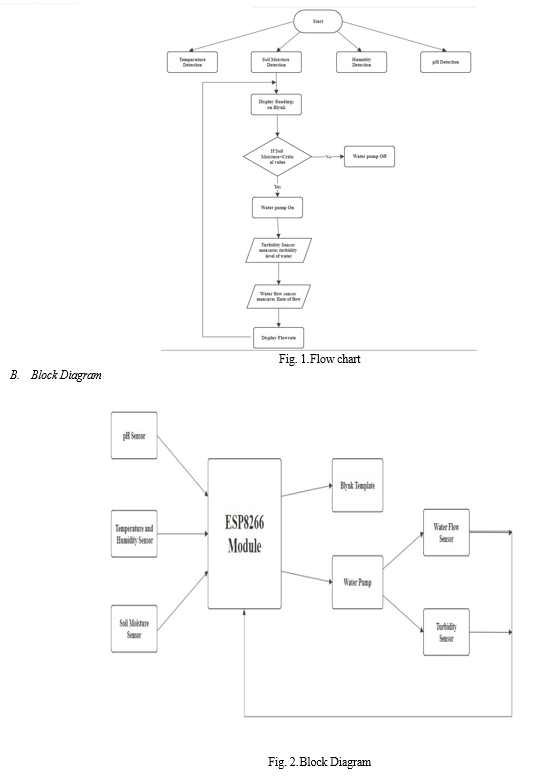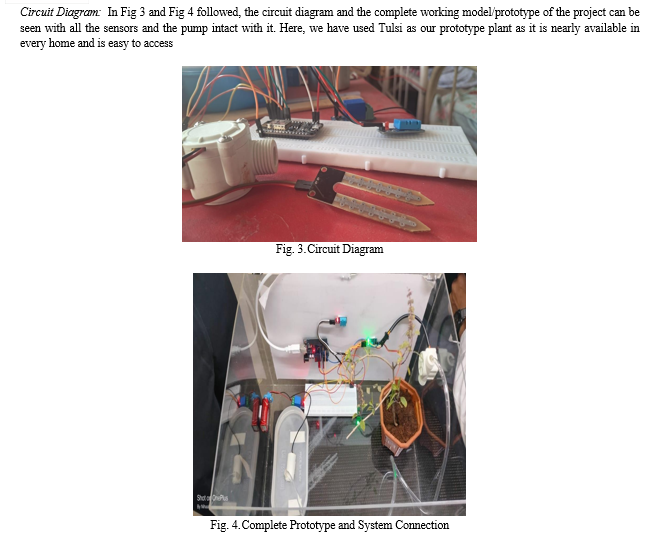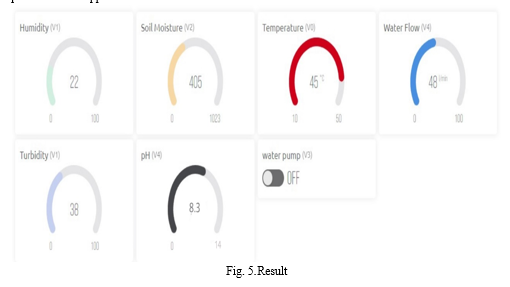Ijraset Journal For Research in Applied Science and Engineering Technology
- Home / Ijraset
- On This Page
- Abstract
- Introduction
- Conclusion
- References
- Copyright
Wireless Automated Irrigation System
Authors: Kalpesh V Joshi, Rriddhi D Rathi, Atharva R Raskar, Rashi R Bhansali, Gaurav M Rathi, Nihaal A Rathi, Purva P Rathi
DOI Link: https://doi.org/10.22214/ijraset.2024.63224
Certificate: View Certificate
Abstract
This research paper explores the role of automated irrigation systems in modern agriculture, focusing on their effectiveness in optimizing crop growth, resource utilization, and environmental sustainability. The highly increasing demand for food production, coupled with the need for resource efficiency, has led to increased interest in advanced agricultural technologies. Automated irrigation, consisting of technologies like climate control, irrigation and monitoring systems, presents a promising solution to address these challenges. The study conducts a comprehensive analysis of various automated irrigation technologies, examining their impact on crop yield, resource efficiency, and overall environmental sustainability. Key parameters, such as temperature, humidity, pH of soil and irrigation, are considered to evaluate the system’s effectiveness in creating optimal growing conditions for diverse crops. Additionally, the research investigates the potential conservation of research, including water and energy, achieved through precise automation. The findings of this research aim to contribute to the ongoing discourse on sustainable agriculture, offering valuable insights for policymakers, agricultural practitioners, and researchers. By understanding the impact of automated irrigation, stakeholders can make informed decisions to enhance food production while minimizing the ecological footprint of modern agricultural practices. The study advocates for the integration of advanced technologies as a crucial step towards achieving a balance between agricultural productivity and environmental conservation.
Introduction
I. INTRODUCTION
WIRELESS Automated Irrigation System is a revolutionary application that is revolutionizing agricultural research methodologies and contributing significantly to global sustainability goals. These systems enable real-time data acquisition, precise control mechanisms, revolutionizing the landscape of agricultural research. The core premise of Wireless Automated Irrigation lies in its ability to seamlessly integrate sensors, actuators, and communication modules, creating a networked ecosystem that operates without the constraints of traditional wired systems. This wireless infrastructure enables researchers to remotely collect and analyze critical data on environmental variables, crop health, and energy consumption, fostering a deeper understanding of the relationships between plants and their surroundings. Wireless sensors strategically placed within the irrigation environment can monitor parameters such as temperature, humidity, and soil conditions like soil moisture level,pH level. The wireless connectivity allows for real-time data transmission to a centralized control hub, where advanced algorithms and analytics can be employed to make informed decisions about irrigation and climate control. Wireless Automated Irrigation emerges as a tool for precision farming and advancing our understanding of plant physiology and behavior. This research paper aims to shed light on the practical implications, challenges, and future prospects of Wireless Automated Irrigation Systems in agricultural research, contributing to the ongoing discourse on sustainable and efficient agricultural practices in an increasingly interconnected world.
II. LITERATURE REVIEW
In Paper [1], the authors, J. Wanayama et al. have made ‘The Smart Irri-kit’, which is a solar-powered irrigation control system designed to improve soil health and promote water management practices. It uses a microcontroller unit and solar panel mounted on a movable framework, with sensors transmitting data via USB. The system uses Solid Edge technology, Electroware, and Arduino libraries for hardware, software, and automation. In Paper [2], the authors have proposed two irrigation systems: a solar pumping module charging a battery for water pumping and an automatic irrigation module controlling the water outlet using soil moisture sensors. The programming for automated irrigation system is done on Arduino Uno Board.
In Paper [3], the author focuses on the challenges and benefits of irrigation in greenhouse vegetable production in India. It highlights the use of wireless sensing technology, Arduino, GSM module, moisture sensor, and solar panel in the implementation of an automatic irrigation system. It provides detailed information on the components used in creating an automatic irrigation system, including Arduino Uno, GSM module, and DHT11 sensor.
In Paper [4], the authors have proposed smart irrigation system, based on IoT technology, which effectively monitors soil moisture and temperature to optimize water use for plants. The system demonstrated its ability to switch a pumping motor automatically, providing optimal irrigation based on threshold values of soil moisture and temperature. The smart irrigation system was developed by integrating soil moisture, temperature, and water flow sensors with an Arduino microcontroller. Data sensed by the system was transmitted to a computer for analysis and visualization in graphical format.
In Paper [5], the author discusses a system designed to optimize water usage for agriculture by using soil moisture sensors to inform a centralized server that controls water supply. The system incorporates MATLAB programming to display threshold values and previous data, and utilizes XBee for transmitting soil data to an authorized person's PC. The system uses three types of sensors: temperature, light and soil moisture, which are interfaced with a PIC controller to automatically control a motor for watering the field.
In Paper [6], the author addresses the disadvantages of traditional control algorithms and the advantages of combining wireless instruments with artificial intelligence (AI) algorithms and Internet of Things (IoT) automation. It emphasizes the usage of specially made wireless nodes that have dual-core 32-bit microcontrollers and 868 MHz LoRa modulation, as well as the incorporation of artificial intelligence (AI) into embedded hardware components and cloud-based streaming systems. The connection stability, robustness, and dependability of the configuration that is being given are illustrated in the paper through sample findings from research and commercial greenhouse operations. The study also describes the usage of IoT-enabled devices and wireless sensors for real-time greenhouse environment monitoring and control, with an emphasis on the applications of IoT-based data collecting and sharing system, wireless communication, sensor probes, connectivity boards, and AI-powered automation in greenhouse settings. Artificial intelligence's application to greenhouse automation is also covered, emphasizing how it may optimize microclimate control, minimize water and chemical requirements, and cut down on energy consumption.
In Paper [7], the author The author uses a smart microcontroller, and also soil and temperature sensors which send real time data to the microcontroller, using Wifi or LoRaWAN. Softwares like Arduino IDE and Blynk are used, which connects the software to hardware and controls the hardware remotely, respectively. Other Electrical Components used were a water pump, relay module and the Arduino kit. The author made a table of the temperature and moisture requirements of some major crops and wrote a code on the Blynk app to perform the required tasks.
In Paper [8], the author uses Microcontrollers, temperature and moisture sensors for the soil, Bluetooth connectivity, and an Android app for remote control and monitoring make up the system. With the help of sensors, it reduces water waste and allows remote operation by automating irrigation based on sensor data. In order to address water shortages and improve sustainability, the article emphasizes the importance of modernizing agricultural techniques.
In Paper [9], the authors integrate IoT-powered Smart Irrigation Systems to improve water-use efficiency for Sustainable agriculture. It describes how IoT and sensory systems efficiently monitor soil conditions, optimize irrigation, and save water using various sensors. Smart irrigation uses data-intensive techniques to maximize agricultural output while reducing its negative effects on the environment.
III. METHODOLOGY/EXPERIMENTAL
To integrate wireless technology we needed to switch from Arduino UNO to ESP8266. As IoT was being used and we were unaware about it , we needed to re-do our whole work , learning and understanding things simultaneously. One of the shortcomings is the potential for sensor failure in automated systems. Sensor malfunctions can lead to inaccurate data collection, which can affect the overall performance and efficiency of the system. Implementing and managing an automated irrigation system can also be complex. From selecting the right sensors and equipment to integrating various components, it requires expertise and careful planning.
Additionally, regular maintenance is necessary to ensure optimal performance of automated systems.
A. Flowchart
The basic working of the project is that when the program is run it gets the data from various sensors, then it checks the condition about moisture levels and directs the water pump, which is connected to the relay module, accordingly.


C. Components
- ESP8266 Module
- Soil Moisture Sensor
- Temperature & Humidity Sensor
- Water Flow Sensor
- pH Sensor
- Turbidity Sensor
- Relay Module
- Water Pump
- Battery
- Water Tube
- Bread Board
- Jumper Wire
- Button
D. Algorithm
The algorithm of this system is very simple.
- In this system, the temperature and the humidity sensor detect the respective parameters around the soil; the soil moisture sensor and pH sensor observes and senses the moisture level and pH of the soil respectively.
- When the soil moisture sensor observes the moisture level to be low it automatically switches the water pump on with the help of a microcontroller, relay module and irrigates the plant.
- As water will flow through the tube into the plant, it will pass through the WaterFlow sensor and turbidity sensor which will calculate the rate of flow of water and turbidity levels of water respectively.
- After supplying sufficient water, as needed by the particular plant after keeping in mind the temperature and humidity, till the soil retains the required moisture, it automatically stops the pump.
- This whole data collected by sensors is sent to the template formed on the Blynk application which can be seen by the user.
- The pump can also be controlled manually using a button.
E. Testing
The project consisted of a wide range of sensors, such as the DHT11, water flow sensor, soil moisture sensor, pH sensor and turbidity sensor. It was crucial to thoroughly test each sensor individually multiple times before finalizing the circuitry of the project and publishing the research paper. Initially, we conducted tests using the Arduino UNO board. Fortunately, all the sensors functioned properly when connected to the Arduino UNO. However, we encountered a significant challenge when it came to integrating the Arduino UNO board with the software. While we were able to display the sensor values on the Serial Monitor, we faced difficulties in showcasing the key readings on our app. Determined to find a solution, we explored other tools that could assist us on our journey. It was during this search that we came across the ESP8266 module. Conducting tests with the ESP8266 proved to be highly beneficial for our project. Nonetheless, we still faced a hurdle in obtaining the output on any external application.
Thus, we decided to try our project with an application called Blynk. Initially, we tested the outputs on Blynk individually for each sensor, and to our delight, they worked with 100% accuracy. Encouraged by this success, we proceeded with our final round of testing, encompassing all the sensors and the water pump button. After numerous attempts and considerable perseverance, we ultimately achieved success. Our project successfully operated as expected, consistently providing accurate readings.
IV. RESULTS AND DISCUSSIONS
Next we can see the app page while the system is working. The app shows all the spheres of working, the humidity, temperature, soil moisture, pH and the turbidity and rate of water flowing at the current time. If the user wishes to switch on the water pump for excess water or does not want to provide water on some particular day he can do so and control the system wirelessly using the on/off button provided in the app menu.

V. FUTURE SCOPE
Looking ahead, the future scope of our wireless automated irrigation system project encompasses several exciting avenues for development.
- We intend to focus on scalability, ensuring that the system can seamlessly adapt to various irrigation system sizes and diverse crop requirements.
- Advanced sensor integration is a key aspect, aiming to enhance precision in monitoring by incorporating sensors that can detect specific parameters crucial for plant growth.
- Additionally, developments in machine learning and AI could further improve the system's efficiency by predicting irrigation needs based on weather patterns and plant-specific requirements.
- As sustainability becomes a focus, incorporating solar-powered components and exploring water-saving techniques will likely be key areas of innovation.
VI. ACKNOWLEDGMENT
We would like to express our sincere gratitude to Prof. Kalpesh V. Joshi for their invaluable guidance and unwavering support throughout the course of this product designing and development project. Their expertise, constructive feedback, and encouragement have been instrumental in shaping the outcome of our work.
We are also deeply thankful to Vishwakarma Institute of Technology for providing an enriching academic environment that fosters creativity and innovation. The resources, facilities, and opportunities offered by the college have significantly contributed to the success of this project.
Thank you all for your support and inspiration.
Conclusion
Finally, our research paper presents a very effective and user-friendly automated irrigation systems which typically leads to increased efficiency by automating tasks such as watering and temperature control.We explored the integration of more advanced sensors to enhance data collection capabilities The project likely contributes in creating and maintaining optimal growing conditions for plants. This could include monitoring and controlling factors such as temperature, humidity and light. The project incorporates sensors and data collection, it likely enables data-driven decision-making. Analyzing the collected data can provide valuable insights into the irrigation environment and help in making informed adjustments for better outcomes. Automation can contribute to resource conservation by precisely delivering water.
References
[1] Wanyama J, Soddo P, Nakawuka P, Tumutegyereize P, Bwambale E, Oluk I, Mutumba W, Komakech A J, “Development of a solar powered smart irrigation control system Kit,” Smart Agricultural Technology Volume 5 [2] Kumar G R, Gopal T V, Sridhar V, Nagendra G, “Smart Irrigation System,” International Journal of Pure and Applied Mathematics (IJPAM) Volume 119 No. 15 2018, 1155-1168 [3] Singh S, “A Research Paper on Automatic Irrigation System,” Journal of Emerging Technologies and Innovative Research August 2018, Volume 5, Issue 8 [4] Asmae El Mezouari, Aziz El Fazziki, Mohammed Sadgal, “Smart Irrigation System,”IFAC-PapersOnLine Volume 55, Issue 10, 2022, Pages 3298-3303. [5] Pathan S, Hate S G, “Automated Irrigation system using Wireless Sensor Network,” International Journal of Engineering Research & Technology (IJERT) [6] Shamshiri R R, Hameed I A, Thorp K R, Balasundram S K, Shafian S, Fatemieh M, Sultan M, Mahn B, Samiei S, “Greenhouse Automation using Wireless Sensors and IoT Instruments integrated with Artificial Intelligence,” IntechOpen [7] Ananthan S S, “Smart Irrigation,” International Journal for Research in Applied Science and Engineering Technology [8] Ashwini B V, “A Study on Smart Irrigation System Using IoT for Surveillance of Crop-Field,” International Journal of Engineering & Technology [9] Ramadan, “An overview of smart irrigation systems using IoT,” Energy Nexus Volume 7,2022,100124, ISSN 2772-4271.
Copyright
Copyright © 2024 Kalpesh V Joshi, Rriddhi D Rathi, Atharva R Raskar, Rashi R Bhansali, Gaurav M Rathi, Nihaal A Rathi, Purva P Rathi. This is an open access article distributed under the Creative Commons Attribution License, which permits unrestricted use, distribution, and reproduction in any medium, provided the original work is properly cited.

Download Paper
Paper Id : IJRASET63224
Publish Date : 2024-06-10
ISSN : 2321-9653
Publisher Name : IJRASET
DOI Link : Click Here
 Submit Paper Online
Submit Paper Online

